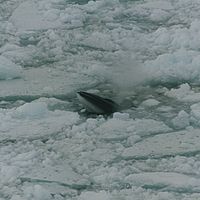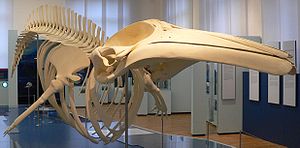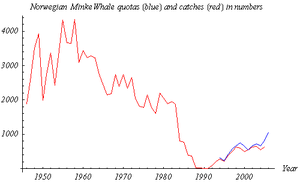- Minke whale
-
Minke whale 
A surfacing minke whale, Skjálfandi, Iceland 
Size compared to an average human Conservation status Scientific classification Kingdom: Animalia Phylum: Chordata Class: Mammalia Subclass: Eutheria Order: Cetacea Suborder: Mysticeti Family: Balaenopteridae Genus: Balaenoptera Species: B. acutorostrata
B. bonaerensisMinke whale (
 /ˈmɪŋki/), or lesser rorqual, is a name given to two species of marine mammal belonging to a clade[1] within the suborder of baleen whales. The minke whale was given its official designation[2] by Lacepède in 1804,[3] who described a dwarf form of Balænoptera acuto-rostrata.[4] The name is a partial translation of Norwegian minkehval, possibly after a Norwegian whaler named Meincke, who mistook a northern minke whale for a blue whale.[5]
/ˈmɪŋki/), or lesser rorqual, is a name given to two species of marine mammal belonging to a clade[1] within the suborder of baleen whales. The minke whale was given its official designation[2] by Lacepède in 1804,[3] who described a dwarf form of Balænoptera acuto-rostrata.[4] The name is a partial translation of Norwegian minkehval, possibly after a Norwegian whaler named Meincke, who mistook a northern minke whale for a blue whale.[5]Contents
Taxonomy
Most modern classifications split the minke whale into two species;
- Common minke whale or northern minke whale (Balaenoptera acutorostrata), and
- Antarctic minke whale or southern minke whale (Balaenoptera bonaerensis).[6]
Taxonomists further categorize the common minke whale into two or three subspecies; the North Atlantic minke whale, the North Pacific minke whale and dwarf minke whale. All minke whales are part of the rorquals, a family that includes the humpback whale, the fin whale, the Bryde's whale, the sei whale and the blue whale.
The junior synonyms for B. acutorostrata are B. davidsoni (Cope 1872), B. minimia (Rapp, 1837) and B. rostrata (Fabricius, 1780). There is one synonym for B. bonaerensis - B. huttoni (Gray 1874).
Writing in his 1998 classification, Rice recognized two of the subspecies of the common minke whale - B. a. scammoni (Scammon's minke whale) and a further (taxonomically) unnamed subspecies found in the Southern Hemisphere to which he gave the common name the dwarf minke whale (first described by Best, 1986).
On at least one occasion, an Antarctic minke whale has been confirmed migrating to the Arctic.[7][8] In addition, at least one wild hybrid between a common minke whale and an Antarctic minke whale has been confirmed.[7][8]
Description
The minke whales are the second smallest baleen whale; only the pygmy right whale is smaller. Upon reaching sexual maturity (6–8 years of age), males measure an average of 6.9 m (23 ft) and females 7.4 m (24 ft) in length, respectively. Estimates of maximum length vary from 9.1 to 10.7 m (30 to 35 ft) for females and 8.8 to 9.8 m (29 to 32 ft) for males. Both sexes typically weigh 4–5 t (3.9–4.9 long tons; 4.4–5.5 short tons) at maturity, and the maximum weight may be as much as 14 t (14 long tons; 15 short tons).
The minke whale is a black/gray color. Common minke whales (Northern Hemisphere variety) are distinguished from other whales by a white band on each flipper. The body is usually black or dark-gray above and white underneath. Minke whales have between 240 and 360 baleen plates on each side of their mouths. Most of the length of the back, including dorsal fin and blowholes, appears at once when the whale surfaces to breathe.
Minke whales typically live for 30–50 years; in some cases they may live for up to 60 years.
The brains of minke whales have around 12.8 billion neocortical neurons and 98.2 billion neocortical glia.[9]
Behavior
The whale breathes 3–5 times at short intervals before 'deep-diving' for 2–20 minutes. Deep dives are preceded by a pronounced arching of the back. The maximum swimming speed of minkes has been estimated at 38 km/h (24 mph).
Reproduction
The gestation period for minke whales is 10 months, and calves measure 2.4 to 2.8 m (7.9 to 9.2 ft) at birth. The newborns nurse for five to possible 10 months. Breeding peaks during the summer months. Calving is thought to occur every two years.[10]
Population and distribution
Multimedia relating to the minke whale
Note that whale calls have been sped up to 10x their original speed.Minke whales are widely distributed throughout the world, commonly found from the poles to the tropics, but they prefer the open sea.
In the northeastern Atlantic, the total population of minke whales is estimated to be on the order of 103,000 (95% confidence interval, International Whaling Commission Scientific Committee 2008.)[citation needed]
Recent genetic studies of Antarctic minke whales indicate the current population is likely to be lower than, or equal to historical levels. According to analyses by Ruegg, et al., the long-term population size of the Antarctic minke whale is estimated at 670,000 individuals.[11] The authors also argue '“The research suggests that direct competition for food is not keeping the [other species] large whale populations from recovering".
Final circumpolar estimates from the International Whaling Commission (IWC) IDCR/SOWER population surveys (1978/79-2003/04) were 338,000 — only 39% of the 1985/86-1990/91 surveys.[12] As of January, 2010, The IWC states it is "unable to provide reliable estimates at the present time" and that a "major review is underway by the Scientific Committee."[13]
As of 2008, one estimate submitted to the IWC Scientific Committee by the Japanese government researchers suggested that for Southern Hemisphere (CPIII with common Northern Boundaries) is 665,074.[14] In the early 1990s, the IWC Scientific Committee agreed minkes in the Southern Hemisphere numbered 760,000 (CPII), which the Japanese whaling industry currently uses as the (2005) estimate.[citation needed] In 2000, however, the Committee withdrew this advice in light of new survey data suggesting 50% lower population than in the 1980s.[15]
The IUCN Red List labels the northern species as Least Concern and the southern as Data Deficient. CITES, on the other hand, lists both species in Appendix I (threatened), with the exception of the west Greenland stock, which is given in Appendix II (trade controls required). The dwarf minke whale (B. acutorostrata subspecies) has no population estimate, and its conservation status is categorized as Data Deficient.
Whaling
Main article: WhalingWhaling was mentioned in Norwegian written sources as early as the year 800, and hunting minke whales with harpoons was common in the 11th century[citation needed]. In the nineteenth century, they were considered too small to chase, and received their name from a young Norwegian whale-spotter in the crew of Svend Foyn, who harpoooned one, mistaking it for a blue whale and was derided for it.[16]
By the end of the 1930s, they were the target of coastal whaling by Brazil, Canada, China, Greenland, Japan, Korea, Norway, and South Africa. Minke whales were not then regularly hunted by the large-scale whaling operations in the Southern Ocean because of their relatively small size. However, by the early 1970s, following the overhunting of larger whales such as the sei, fin, and blue whales, minkes attracted their attention. By 1979, the minke was the only whale caught by Southern Ocean fleets. Hunting continued apace until the general moratorium on whaling began in 1986.
Following the moratorium, most hunting of minke whales ceased. Japan continued catching whales under the special research permit clause in the IWC convention, though in significantly smaller numbers. The stated purpose of the research is to establish data to support a case for the resumption of sustainable commercial whaling. Environmental organizations and several governments contend that research whaling is simply a cover for commercial whaling. The 2006 catch by Japanese whalers included 505 Antarctic minke whales.
Although Norway initially followed the moratorium, they had placed an objection to it with the IWC and resumed a commercial hunt in 1993. The quota for 2006 was set at 1,052 animals, but only 546 was taken.[17] The quota for 2011 is set at 1286.[18] In August 2003, Iceland announced it would start research catches to estimate whether the stocks around the island could sustain hunting. Three years later, in 2006, Iceland resumed commercial whaling.
A 2007 analysis of DNA fingerprinting of whale meat estimated South Korean fishermen caught 827 minke between 1999 and 2003.[19]
Amount of whales killed either instantaneously or more than 5 minutes after first contact of weapon> [20][clarification needed][citation needed]
File:Japan Instantaneous and LSD kills since acquiring new 'super harpoon' 2007-2010
Season Amount of whales killed Instantaneous deaths 5 minutes or more 07/08 825 579 246 08/09 936 608 328 09/10 1296 973 323 File:Japan Instantaneous and LSD kills between 1990–1993 (Before 'super harpoon')
Season Amount of whales killed Instantaneous deaths 5 minutes or more 90/91 678 269 409 91/92 871 187 684 92/93 816 397 419 Whale-human interaction
 Minke whale in the Ross Sea
Minke whale in the Ross Sea
Due to their relative abundance minke whales are often the focus of whale-watching cruises setting sail from, for instance, the Isle of Mull in Scotland, County Cork in Ireland and Húsavík in Iceland, and tours and that taken on the east coast of Canada. Minke whales are frequently inquisitive and engage in 'human-watching'; however, perhaps due to commercial whaling, older minke whales are not as inquisitive as younger ones. In contrast to spectacularly acrobatic humpback whales, minkes do not raise their flukes out of the water when diving and are less likely to breach (jump clear of the sea surface). This, combined with the fact that minkes can stay submerged for as long as twenty minutes, has led some whale-watchers to label them 'stinky minkes'.[21]
In the northern Great Barrier Reef (Australia), a swim-with-whales tourism industry has developed based on the June/July migration of dwarf minke whales. A limited number of reef tourism operators (based in Port Douglas and Cairns) have been granted permits by the Great Barrier Reef Marine Park Authority to conduct these swims, given strict adherence to a Code of Practice, and that operators report details of all sightings as part of a monitoring program. Scientists from James Cook University and the Museum of Tropical Queensland have worked closely with participating operators and the Authority, researching tourism impacts and implementing management protocols to ensure that these interactions are ecologically sustainable.
Minke whales are also occasionally sighted in Pacific waters, in and around the San Juan Islands of Washington State.
In 2010, a minke whale swam for two hours with a surfer who was stand up paddle surfing from Santa Catalina Island to Dana Point in southern California. The whale swam close to her, rolled around repeatedly alongside her, and blew bubbles beneath her board.[22]
2007 Amazon incident
In November 2007, a minke whale ran aground on a sandbar in the Amazon jungle some 1,600 kilometers (990 mi) from the ocean. Scientists said the whale was 5.5-metre (18 ft) long. The whale beached near Santarém in Pará state, Brazil's Environmental Protection Agency said.[23] Its corpse was discovered the following week "by local people who reported it to the authorities."[24]
References
- ^ Arnason, U., Gullberg A. & Widegren, B. (1993). "Cetacean mitochondrial DNA control region: sequences of all extant baleen whales and two sperm whale species". Molecular Biology and Evolution 10 (5): 960–970. PMID 8412655. http://mbe.oxfordjournals.org/cgi/content/abstract/10/5/960. Retrieved 2007-07-13.
- ^ It had been inaccurately described by the Danish zoologist Johann Christian Fabricius in 1780, who assumed it must be an already described species, assigned his specimen to Balaena rostrata, a name, however, that was already in use.
- ^ Lacepède, Histoire naturelle des cétacées. (Paris, 1804).
- ^ Modern orthography makes it Balaenoptera acutitostrata.
- ^ "Dictionary.com". http://dictionary.reference.com/browse/minke. Retrieved 2007-08-30.
- ^ Mead, James G.; Brownell, Robert L., Jr. (16 November 2005). "Order Cetacea (pp. 723-743)". In Wilson, Don E., and Reeder, DeeAnn M., eds. Mammal Species of the World: A Taxonomic and Geographic Reference (3rd ed.). Baltimore: Johns Hopkins University Press, 2 vols. (2142 pp.). ISBN 978-0-8018-8221-0. OCLC 62265494. http://www.bucknell.edu/msw3.
- ^ a b "Antarctic minke whales migrate to the Arctic". Whales On Line. February 3, 2011. http://bed2.gremm.org/eng/pag.php?PagRef=Nws&NwsId=4475. Retrieved 2011-06-15.
- ^ a b Glover, K., et al (2010). Migration of Antarctic Minke Whales to the Arctic. 5. PLoS ONE. doi:10.1371/journal.pone.0015197. http://www.plosone.org/article/info:doi/10.1371/journal.pone.0015197. Retrieved 2011-06-15.
- ^ N. Eriksen, Bente Pakkenberg (January 2007). "Total neocortical cell number in the mysticete brain". Anat. Rec. 290 (1): 83–95. doi:10.1002/ar.20404. PMID 17441201.
- ^ http://www.acsonline.org/factpack/MinkeWhale.htm American Cetacean Society: Minke Whale
- ^ Ruegg K., Anderson E., Baker C.S., Vant M., Jackson., and Palumbi S.R., "Are Antarctic minke whales unusually abundant because of 20th century whaling?", Molecular Ecology, 2010. available at http://lenfestocean.org/publications/minke_whales.html
- ^ T.A. Branch (2006). "Abundance estimates for Antarctic minke whales from three completed circumpolar sets of surveys, 1978/79 to 2003/04". IWC SC paper SC/58/IA18: 28.
- ^ "Whale Population Estimates". http://www.iwcoffice.org/conservation/estimate.htm. Retrieved January, 2010.
- ^ Hiroshi Okamura and Toshihide Kitakado. "Abundance Estimates of Antarctic Minke Whales from the Historical IDCR/SOWER Survey Data Using the OK Method". http://www.iwcoffice.org/_documents/sci_com/SC60docs/SC-60-IA8.pdf. Retrieved 2010-01-06.
- ^ Branch & Butterworth 2001
- ^ Joseph Horwood, Biology and exploitation of the minke whale (CRC Press) 1989:3.
- ^ Tok bare halve hvalkvoten - lofotposten.no
- ^ Samme hvalkvote som i år - www.p4.no
- ^ Aldhous, Peter (10 May 2007). "High value of whale meat costs minkes in Korea". New Scientist 194 (2603): 10. doi:10.1016/S0262-4079(07)61160-9. http://environment.newscientist.com/article/mg19426034.100-high-value-of-whale-meat-costs-minkes-in-korea.html.
- ^ Hunting Weaponry Advances Records Service 2011 in Report of the International Task Force on Whaling, Environment Japan, Jan 2011
- ^ Look out, it's Stinky Minke - there she blows!, independent.co.uk, July 31, 2005
- ^ California surfer receives whale of an escort during marathon paddle, grindtv.com, April 1, 2010
- ^ Duffy, Gary (17 November 2007). "Whale found deep in Amazon jungle" (web). BBC News, Sao Paulo. http://news.bbc.co.uk/2/hi/americas/7099625.stm. Retrieved 2007-11-17.
- ^ "Whale lost in Amazon found dead" (web). BBC News. 21 November 2007. http://news.bbc.co.uk/2/hi/americas/7105578.stm. Retrieved 2007-01-01.
- General references
- "Balaenoptera acutorostrata". Integrated Taxonomic Information System. http://www.itis.gov/servlet/SingleRpt/SingleRpt?search_topic=TSN&search_value=180524. Retrieved 18 March 2006.
- "Balaenoptera bonaerensis". Integrated Taxonomic Information System. http://www.itis.gov/servlet/SingleRpt/SingleRpt?search_topic=TSN&search_value=612592. Retrieved 18 March 2006.
- Branch, T. A., and D. S. Butterworth. 2001. "Southern Hemisphere minke whales: standardised abundance estimates from the 1978/79 to 1997/98 IDCR/SOWER surveys". Journal of Cetacean Research and Management 3:143-174.
- Minke Whales, Rus Hoelzel and Jonathon Stern, ISBN 1-900455-75-7
- National Audubon Society Guide to Marine Mammals of the World, Reeves, Stewart, Clapham and Powell, ISBN 0-375-41141-0
- Whale Watching in Iceland, Asbjorn Bjorgvinsson and Helmut Lugmayr, ISBN 9979-761-55-5
- Whales & Dolphins Guide to the Biology and Behaviour of Cetaceans, Maurizio Wurtz and Nadia Repetto. ISBN 1-84037-043-2
- Encyclopedia of Marine Mammals, editors Perrin, Wursig and Thewissen, ISBN 0-12-551340-2
- Odin Norwegian Ministry of Foreign Affairs
- "Modes of Production and Minke Whaling: The Case of Iceland", Gísli Pálsson (2000).
Further reading
OhUallachain, D. ad Debvaney, D. 2010. Minke whale (Balaenoptera acutorostrata Lacepede) at Ballyhealy, Co. Wexford. Ir Nat. J. 31: 55.
External links
- Newton North HS oceanography project - general information
- Project Minke - Minke whales from the West Coast of Scotland
- Northeast Pacific Minke Whale Project - Minke whales from the Northeast Pacific
- Dwarf Minke Whales - Great Barrier Reef Marine Park Authority - list of permitted swim-with-dwarf minke whales tourism operators on the Great Barrier Reef
- Minke Whale Project - Dwarf minke whale research team based at James Cook University, North Queensland, Australia
- ARkive Stills, video.
- NMV Photo of skull.
Categories:- IUCN Red List least concern species
- Baleen whales
- Fauna of Ireland
- Mammals of Europe
- Fauna of Greenland
- Cetaceans of Australia
- Megafauna of Eurasia
- Megafauna of Africa
- Megafauna of Australia
- Megafauna of South America
- Megafauna of North America
- Fauna of the Atlantic Ocean
- Fauna of the Pacific Ocean
Wikimedia Foundation. 2010.



